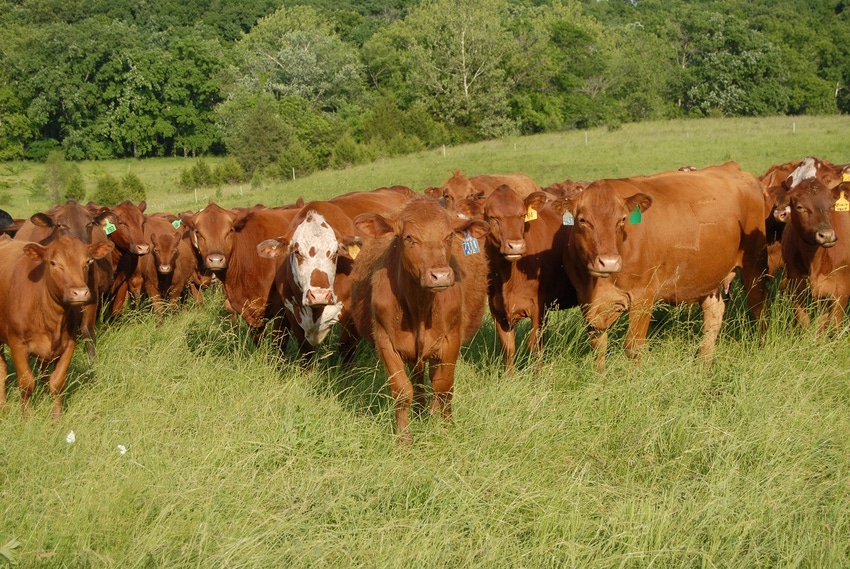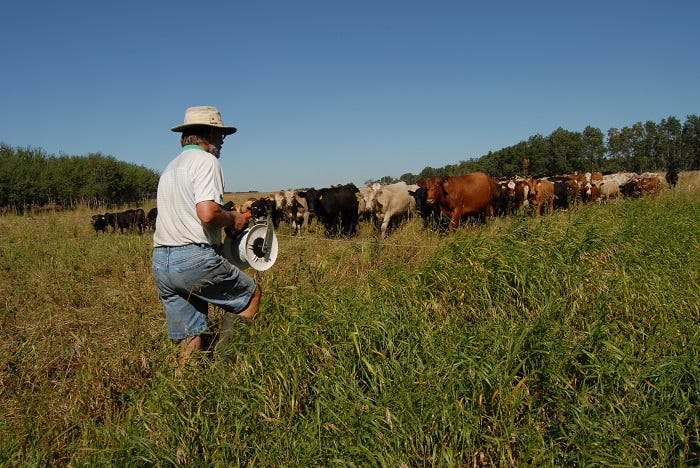All life is grass
Author says the grass farming movement might offer entry points for vets with the right knowledge set.
November 6, 2018

Author and contrarian H.L. Mencken once said, “For every complex problem there is an answer that is clear, simple and most likely wrong.”
As a partially retired veterinarian with more than 40 years in the cattle business, I tend to agree. Our industry has spent much of the past seven decades replacing standing forage for cattle with harvested and stored feedstuffs, mostly grain. Agriculture has become a business of engineering equipment, buildings, storage units, processors, chemicals and delivery systems. Most of our clients and likely ourselves have become a part of the “material handling business.”
Initially, all this process seemed to be the simple answer to efficiently take the meat from the field and deliver it to the consumer: Research and assault the problems with housing, balanced rations and biologicals was deemed the answer.
Now the end product (beef) lacks much of the nutrient density of the past and we have flip-flopped the fatty acid profile. Even the beef checkoff scientists now recommend small consumption of the product. Also, our clientele in large part have left the cattle business and removed their fences or moved to town.
Please remember that I was educated and totally indoctrinated into the industrial model during the 1970s, so I'm speaking as a former insider.
Now that most cattle clients have exited the cattle business, it might be a good time for many of us to wake up and look around. What we will find is that a new cattle industry based on cattle self-harvesting their own feed got up and going (actually re-started) back in the early 1980s.
I would suggest that cattle doctors get excited about this grass-farming movement and the potential it offers.
Reshape thinking
A veterinary education is supposed to be learning principles, solving problems at the root with consideration of wholes, and most importantly learning how to think. Here is a place and time we can apply this training.
The truth is that the principles of nature are quite simple but they are governed by complexity that we spend most of our careers trying to understand and grasp, often with limited success. Building and maintaining a cattle practice is no exception in the ranch and farm environment of today.
In the early years of the grass-farming movement, much of the information and teaching came from New Zealand, Argentina and Africa. Many of the biological principles were not completely applicable to North America and at least some of it was just plain wrong. Nonetheless, great progress has been made and the economics are sound.
In the spring of 1988 I spent a day with 100 or more veterinarians listening to a Wisconsin veterinarian and looking at his slides and figures on a rotational grazing program. At the time my nights were spent shoveling feed to two potloads of steers or spayed heifers every winter and slowly ruining my back and alienating my family. I got real interested in what my colleague had to say.
The thought and possible reality of allowing cattle to move in tight groups and big densities for very short periods turned my lights on. I quickly realized that it takes grass to grow grass and there would be very little growth with these cattle standing on top of it. We could actually grow huge amounts of feed and then self harvest if we had cattle control and movement and land rest.
I missed a bunch of what I would later find to be extremely important but the initial teaching and my limited understanding carried me through 15 years of trials and searching for additional knowledge. Later I traveled to Mississippi and met and visited with Dr. Gordon Hazard, an old veterinarian who I had heard called “the guru of grass.”
Further, I have always had great interest in nutrition and knew that with mechanical harvest and storage there is always a large nutrient loss. Years later, after a lot of study and some more experience, I began to see the relationship of the healthy soil and plants and cattle health. Ultimately that led me to human health understandings. I eventually concluded that cattle harvested from the right kind of farming environment and program provide many of the answers to health concerns and the beef was healing. I learned the high conjugated linolenic acid and omega 3 fatty acids in beef -- both powerful anti-inflammatory agents -- were dependent on a forage diet. I already knew that high-grain diets were shortening our cows’ lifespans and our bulls’ longevity. It is the same for humans.
I began to see the scripture in Isaiah 40:6 that "all flesh is grass" as a great and complex truth.
With all these paradigm changes under my belt, my recommendation for young veterinarians and old practitioners like myself who have concluded that the brokenness of the old model is no longer fixable is to retool our education and thought processes.
Thousands of neophytes to cattle agriculture have cattle on grass as their interest. These people are entering animal agriculture and are potential veterinary clients. Also, younger men are taking over operations from their tradition-minded fathers and they are showing interest.
The natural model
It is paramount that we veterinarians again get a grasp of the entirety of what I call the natural model. That's because the grass-farming movement has its base in the concept that large ruminants often grazed in huge herds and were surrounded by predators and kept in close-knit, sometimes agitated herds across most prairies and savannahs in North America. Most soil fertility was built as the result of the huge herds traveling and living in very high densities and their here-today and gone-for-many-tomorrows relationship to the land.
With today’s information age much of what we need to learn is available from cyberspace. You will find that the microbial world, the soil, the mineral and the plant world is not as antagonistic as Louis Pasteur proclaimed in his thesis of disease.
In fact, species richness in the soil and above the soil, in every level of the food chain is actually beneficial. For example, entomologist Jonathan Lundgren of Blue Dasher Farm says that for every single pest species of insect there are 1,700 species that are either beneficial or neutral for farmers. Most of us in veterinary practice should have learned by now this is true in the world of microbiology, as well.
The benefits we have observed coming from natural model management principles in the past 15 years include:
Doubling of cattle stocking rates.
Doubling and often tripling of farm/ranch profitability.
Tremendous reduction of production costs.
Shortening and often the elimination of winter feeding.
Elimination of purchased fertilizer, mechanical harvest and feed storage.
Truly healthy calves and yearlings.
Drought, flood and emergency proofing of cattle operations.
Real working knowledge of genetics.
Return of wildlife.
Rapid restoration of formerly abused land in two to five years.
Satisfaction in our daily endeavors and the ability to be proactive rather than reactive.
For you that pursue learning grass farming a new mode of practice will likely reveal itself. This may be a life based on supporting health and success stories rather than fighting fires and getting called to wrecks. Who knows, we might end up with clients that call us first for consultation rather than last to tell us to hurry!

Soil fertility is actually built by high-stock-density grazing, with nutrients passing through to the grazing animals. This helps clients.
More resources on grass farming
Go to www.BeefProducer.com and read and study Walt Davis, Alan Newport and R.P. Cooke. We are archived for years. Call us with questions.
Get a copy of Walt Davis’s book How To Not Go Broke Ranching and study it.
Take a few aggressive clients to grazing meetings and pasture walks.
Study the nutritional facts concerning soil health, plant diversity, animal and human health.
Urge university and state associations to bring in holistic land and cattle management speakers and programs for continuing education.
Consider sponsoring local producer programs.
Get to know your state and regional NRCS grazing specialists, as he or she might send you business.
Consider speaking at your local college, junior college or university. Don’t be afraid to charge for your time.
Remember we do not have to know everything, but we are expected to know more than the folks we work for.
About the Author(s)
You May Also Like



